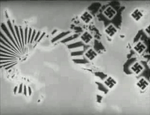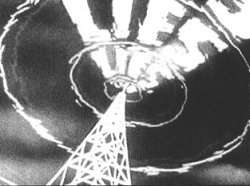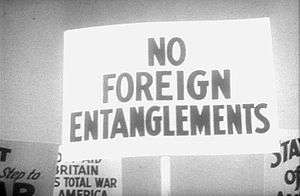Prelude to War
Prelude to War is the first film of Frank Capra's Why We Fight film series, commissioned by the Office of War Information (OWI) and George C. Marshall. It was made to educate American troops of the necessity of combating the Axis Powers during World War II. The film was based on the idea that those in the service would be more willing and able fighters if they knew the background and reason for their participation in the war. It was later released to the general American public as a rallying cry for support of the war.
- For the similarly titled novel by Leslie Charteris, see Prelude for War.
| Why We Fight: Prelude to War | |
|---|---|
Film | |
| Directed by | Frank Capra |
| Produced by | Frank Capra |
| Written by | Anthony Veiller Eric Knight |
| Narrated by | Walter Huston |
| Music by | Uncredited: Hugo Friedhofer Leigh Harline Arthur Lange Cyril J. Mockridge Alfred Newman David Raksin |
| Cinematography | Robert Flaherty |
| Edited by | William Hornbeck |
| Distributed by | 20th Century Fox War Activities Committee of the Motion Pictures Industry |
Release date |
|
Running time | 53 minutes |
| Country | United States |
| Language | English |
Plot

In an edit added to the film before public release, a comment by Henry L. Stimson, the Secretary of War at the time, was quoted to create trust with the audience, "the purpose of these films is to give factual information as to the causes, the events leading up to our entry into the war and the principles for which we are fighting."

The purpose of the OWI was to use mass communication to appeal to both serving soldiers and later, the American population on the reasons for the war; therefore, they released Prelude to War to further these goals.[1] The film commences with an explanation of how Americans were brought into the war through heroic motives to protect countries unable to protect themselves. The film expresses the view that America had this duty to righteousness and Christian values throughout history, according to the values and beliefs set forth by the founding fathers.[2][3]
The documentary makes use of compare and contrast methods throughout the film in order to transmit its heroic message. The primary images used within the film to portray the opponents of America are introduced by Henry Wallace as the "free world" — a brightly illuminated planet of the Allies, and a "slave world" as a planet deep in shadow of the Axis Powers.
It examines the differences between the U.S. and the fascist states of Benito Mussolini, Adolf Hitler and Yamamoto, portraying the latter countries working together as gangsters to conquer the world. In order to do this, Capra made use of footage from Triumph of the Will, but with different narration designed to support the Allied cause.
It is brought to the audience's attention that after the Nazis smashed the opposing political parties and labor unions they turned their attention to their last remaining obstacle — the church. In one scene a stained glass window is shattered by several bricks to reveal a "Heil Hitler!" poster behind. To emphasize this depiction of Hitler as an antichrist figure, a class of German schoolchildren is shown singing to the song Frederick Rex:
Adolf Hitler is our Saviour, our hero
He is the noblest being in the whole wide world.
For Hitler we live,
For Hitler we die.
Our Hitler is our Lord
Who rules a brave new world.
Historical background

In the two decades following World War I and the failure of the League of Nations, a spirit of isolationism became prevalent throughout the United States that persisted up to the attack on Pearl Harbor.[4] This presented a major obstacle in garnering support for the war, as the people of the United States did not feel a sense of unity with other nations of the world, most notably, Europe. In an effort to dispel this isolationist way of thinking, Prelude to War was produced in order to raise the enthusiasm and interest of U.S. troops for the international struggle.[5][6]
The film addressed the need for change in current American citizens' standpoint on the war through interviews with civilians. In response to whether or not America should get involved in the war, Americans were depicted saying "I think we should stay out of it entirely," and "They mean nothing to us." Protesters against the war rallied under slogans like "No Foreign Entanglements." The film argues that, contrary to the public opinion of the time, the problems of the United States "were and always will be dependent upon the problems of the entire world and our peace is gained when there is peace for all."
The film pointed to the Japanese invasion of Manchuria as when World War II begun-"remember that date: Sept 18, 1931 a date you should remember as well as Dec 7, 1941. For on that date in 1931 the war we are now fighting begun." saying that we knew that the aggressors should be stopped but it was impossible to convince the average person "that they should go to war over a mud hut in Manchuria." After going over Japan's invasions of China the film asks about Japan's allies saying that while Hitler was not ready Mussolini was and that Mussolini had to be as his government had not been able to produce what it had promised "so he pulled the old trick of a foreign war to divert from troubles at home". The film then describes just how outclassed Ethiopia was against Italy and how "we hadn't realized that peace for us involves peace for all" and saying that they would take up Hitler in their next film.
Significance in the War
The U.S. Army used Prelude to War as a training film for indoctrinating soldiers before its release in theaters. Prior to deployment, it was compulsory for all U.S. soldiers to view the film. The goal when showing it to the general public was to unify the country and to encourage that everyone should do their part in the war effort. The films produced by Capra inspired the society of the time to mobilize as a nation and rally around their country, their troops, and their president.[1]
The film series was a useful tool in motivating the public and boosted support for the war. It was so well perceived that on March 4, 1943, the Academy of Motion Picture Arts and Sciences awarded an Academy Award to Capra for Prelude to War as the Best Documentary film of 1942, illustrating how the government and military successfully and cohesively relayed their message of national unity to the American people through popular culture.[1]
See also
References
- Kurash, J. "A Prelude to War" (1 March 2009). Retrieved from http://www.army.mil
- Wilkins, J.N. America’s Christian Foundation Archived 2016-11-13 at the Wayback Machine
- German, Kathleen. "Frank Capra's Why We Fight Series and the American Audience." Western Journal of Speech Communication 54. (1990): 237–248.
- Auchincloss, Kenneth (8 March 1999). "Americans Go To War". Newsweek (New York).
- Rollins, Peter C (ed.). (2003) "Indoctrination and Propaganda, 1942–1945" The Columbia companion to American history on film: How the movies have portrayed the American past. Columbia University Press. pp. 118.
- Thomas, Nicholas (ed.). (1990) [1st. Pub. 1965] "Why We Fight". International dictionary of films and filmmakers (2nd ed). St. James Press. pp.976–979.
External links
- Prelude to War is available for free download at the Internet Archive
- Prelude to War on YouTube, posted by the National Archives and Records Administration
- Prelude to War on IMDb